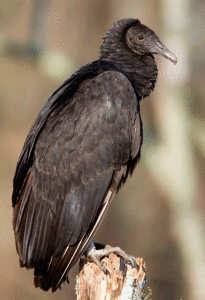 They’re big, they’re a bit smelly, and they eat dead stuff! Vultures might not the prettiest of birds… some might even say ugly. But they are some of the most important animals around you! Vultures are what clean up after the rest of nature. They can make an animal carcass disappear in no time.
They’re big, they’re a bit smelly, and they eat dead stuff! Vultures might not the prettiest of birds… some might even say ugly. But they are some of the most important animals around you! Vultures are what clean up after the rest of nature. They can make an animal carcass disappear in no time.
Some call them buzzards, a name given to them by the first English settlers who thought that they looked like the hawks called buzzards from back home in Europe. They do fit in the larger family of raptors that hawks also belong to, but vultures are vultures, not hawks.
There are only two species of vultures in Texas today, but that was not always true. Besides the common Turkey Vulture and Black Vulture we see almost daily, at some point in history Texas skies also saw California Condors soaring in search of food. Reach even further back and there is a mystery vulture whose wing span was even larger than the condors! Fossil skeleton records from caves have shown both of these species lived here. California Condors have an impressive nine foot wing span… but the ancient bird, thought to be a vulture species, was up to 14 foot!
Our local cleanup crew is now made up of the Turkey Vulture, with their featherless red heads, and its smaller cousin the Black Vulture with an equally featherless head that stays black. Besides the different colored heads, they can be told apart in flight by the much shorter tail on the Black, and their shorter rounder wings that have a “silver” appearance at the wing tip. The Turkey has silver in the wing as well, but it’s the whole trailing edge of the wing, not just the tip. Turkey Vultures also fly with their wings in a dihedral, or slight V shape, often rocking back and forth. Be cautious because you can’t always judge by head color as the young Turkeys have black heads until close to adulthood.
Both vultures eat carrion, and the riper the better it seems. This helps the Turkey Vulture find its food, as they “hunt” by smell. They can smell something dead from a long ways away. The Black Vulture finds its food by sight, and will often cheat by keying in on the Turkeys circling over a dead animal… just follow the guys around that can smell the stuff! And there is a distinct pecking order that can be seen at a carcass. Turkeys go in first, and it may be that they can better start the process with more powerful beaks, etc. If a Crested Caracara joins the fray they wait their turn after the Black Vultures. Caracaras are not vultures (nor eagles) and closer related to falcons, but they do eat a lot of carrion, however that’s another story.
One “fun” fact about Black Vultures… they “release excrement” on their legs and feet to keep them cool! That is what gives their legs that nice white appearance. But strange as they might be, we must be thankful that these big guys are around! Without them we’d have a much smellier world!
